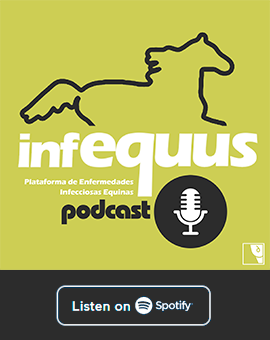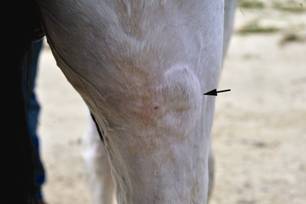Dourine
Etiology
Dourine is a venereal disease produced by Trypanosoma equiperdum that affects equids. T.equiperdum is a protozoal parasite that belongs to the Trypanozoon subgenus among other species associated with disease like T.evansi (Surra) and T.brucei brucei (African animal Trypanosomiasis), whose morphologic, serologic and molecular similarity, makes their differentiation difficult. In fact, there are recent hypothesis that question dourine etiologic classification.
Epidemiology
Dourine is considered a reportable disease by the World Organization for Animal Health (OIE). Is present in most of Asia, Russia, regions of Middle East, southeastern Europe, South America and Africa. Equids are the only natural host of this parasite, which can be found mainly in vaginal secretions of mares and seminal fluid, penis mucous exudate and sheath of stallions. Transmission is direct by coitus. Occasionally foals may become infected during parturition or by ingestion of infected milk.
Pathogeny
Incubation period, severity and duration of the disease are highly variable, from acute cases with 50% mortality and weeks of duration, to chronic cases with mild signs and years of duration, even subclinical cases has been observed. T.equiperdum can pass through intact mucous membranes, stays initially at the mucosal surface and subsequently invade tissues, giving oedematous plaques in genitalia. It can also reach the blood stream and therefore other areas of the organism.
Clinical signs
Clinical signs can wax and wane through time before the animal recovery or death. Initial clinical signs are vaginal discharge, genital and mammary gland oedema. The appearance of cutaneous oedematous plaques is pathognomonic for dourine. Other signs observed are pyrexia, ocular lesions, knuckling of the joints, weakness, ataxia, unilateral facial paralysis, weight loss, emaciation and anaemia.
Diagnosis
Differential diagnoses for dourine are coital exanthema, equine contagious metritis, surra, nagana, anthrax, equine viral arteritis, equine infectious anaemia, purpura haemorrhagica and other conditions leading to emaciation. Diagnosis can be made based on clinical signs in endemic areas and through microscopic identification of the parasite in blood smears, exudates or aspirates from oedematous lesions. Complement fixation is the diagnostic method established by OIE for equine international trade. Other serologic tests available are indirect fluorescent antibody (IFAT), enzyme-linked immunosorbent assays (ELISA) or agar gel inmunodiffusion (AGID) among others. The main macroscopic necropsy findings are inflammatory lesions with gelatinous exudate in genitalia, hypertrophy and/or haemorrhage of abdominal lymphatic nodules and changes in consistency and colour of the spinal cord.
Treatment
Dourine infected animals must be notified to sanitary authorities (OIE) and must be euthanized, consequently treatment is not recommended because animals improve clinically but remain as carriers.
Prevention and control
Disease control in affected countries is based on the report and sanitary eradication of infected animals. International trade control of equine and equine semen, is regulated by each country legislation and OIE’s Terrestrial Animal Sanitary Code. As preventive measure, adequate hygiene is recommended in assisted matings.
Public Health Considerations
Dourine is not considered a zoonotic disease but must be reported to OIE.
References
- Equine Infectious Diseases. 2014 Elsevier Inc. ISBN: 978-1-4557-0891-8.
- OIE, Ficha técnica de la enfermedad.
- Código Sanitario para los Animales Terrestres de la OIE, 2018. Capítulo 12.3. http://www.oie.int/fileadmin/Home/esp/Health_standards/tahc/current/chapitre_dourine.pdf Manual Terrestre de la OIE, 2013. Capítulo 2.5.3.


